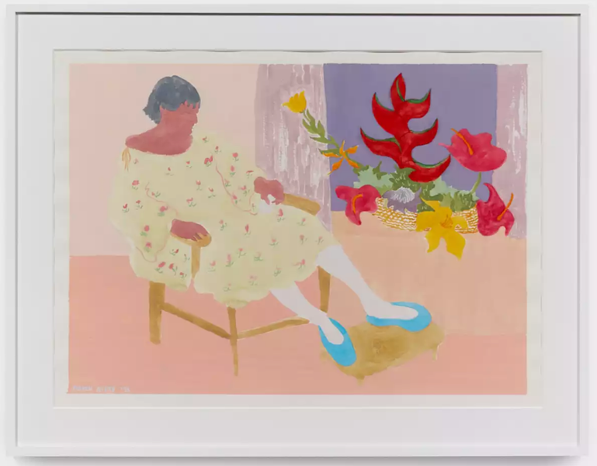
Simplified forms, tactile surfaces, and themes of interiority bring together Parts and Labor’s current exhibition, March Avery and Elisabeth Kley.
As is the case with every show at Parts and Labor, two artists are presented in conversation with one another in order to consider common “impulses and inclinations.” At first glance, the artists seem cut from the same cloth, combining stillness with a playful asymmetry, emphasizing the handmade quality of each medium. However, the more time you spend in the exhibition, the more each artist brings out elements in the other that may otherwise be overlooked.
March Avery’s paintings depict scenes from her private life, distilling intimate moments down to their essential properties. In one painting a young girl sits in a tippy rocking chair. In another, a gray-haired woman signs a book. Across the gallery, a therapist listens to her patient, the blue sky spilling into the room. Behind them, two boys scribble drawings on the floor while a third watches. These vignettes of ordinary life are offset by nonliteral color schemes, creating scenes that are both familiar and imaginative. In looking at Avery’s paintings, I felt the immensity of making work about the every day; how one ordinary moment rolls into the next, and how there are as many paintings as there are moments in one’s life. The quotidian has never looked so good.

The piece that held my attention the longest was Patient and Plant. The watercolor depicts a woman dressed in a floral hospital gown, slouched in a chair, staring at an arrangement of ecstatic flowers. They are too alive for this room, too spirited, but pictorially fit perfectly within the scene. I wondered, is the bouquet a figment of the patient’s imagination or an out-of-place wonder?
As I scanned the surface of the painting I thought of my mom, who lived her last years with Dementia in a nursing home. I thought of the plants people would send, how they gathered on the window sill as reminders of the outside. Avery’s painting reminded me of that strange space between the familiar and the foreign, where things once known slip away and new things come into focus.
I considered this as my eyes moved down the center curtain towards the figure’s ankle, positioned directly in front of the chair’s intersecting leg and spindle. The meeting of ankle and chair is subtle, but it’s the point around which the picture turns. Alignments like these, which appear in every one of Avery’s paintings, are wonderful to discover. They are where my imagination runs wild, but are also where I’m most aware of the painting’s construction.
Moments of mediation and contemplation are harder to come by in Elisabeth Kley’s sculptures. Their complex calligraphic patterns, sourced from a broad range of cultures, channel the deep-rooted undercurrents of our language systems and keep the viewer’s eye alert and on the move.
I think of Kley as a kind of Flaneur, strolling through museum galleries or websites, allowing her vision to drift over surfaces until something captures her attention. She then photographs the source and brings it into her studio, where she works out compositions with brush and ink. It’s from these preparatory drawings that she paints the final designs freehand on the surface of her ceramics. The resulting works behave like Rorschach tests, compelling the viewer to create new meaning from patterns of the past.

Egyptian Shield Bottle, the largest pedestal work in the show, stands like an exoskeletal bug wearing its structure on the surface. I walked around the piece, enjoying its imperfections, dreaming up all kinds of associations. The sculpture looked guarded, protected by ladders and lattice patterns, bordering on bondage. I thought of Giovanni Battista Piranesi’s fantastical etchings of prisons traversed by stairs, ramps, and pulleys. They do not share the same flat bold sensibility of Kley, but they are similarly excessive, suggesting a logic that goes on forever.
I followed the links, waiting for something to hold my gaze or tug on my emotions. This didn’t happen. Instead, my vision pored over the surfaces and edges, leaping from one shape to the next, never resting on anything in particular. Kley’s explorations of pattern and symbolism are written onto her ceramic vessels, emphasizing the playfulness of reading, decoding, and perhaps misinterpreting signs. I did enjoy reading these surfaces, but without a moment for the eye to rest, it was difficult to establish a deeper connection to the work, despite the intrigue and the genuine pursuit by Kley.
Observing the show from a distance, I wondered if these artists occupied different sides of the same coin. Kley’s vessels, which hold interior space, are powerfully extraverted objects, directing my attention away from their centers. Their rich patterns and suggestive designs guided me around their bodies. By comparison, Avery’s paintings are flat and two-dimensional, but their interwoven shapes and muted colors convey a sense of depth. Her quiet meditations on day-to-day life contain surprising visual moments which draw the viewer deeper into her world. Both artists play with form and content, shifting our expectations of their respective mediums.
March Avery and Elisabeth Kley is a compelling exhibition. Though the artists share a similar sensibility, what ignites the conversation between them is their individual inversions of their work. It is in viewing the exhibition as a whole that these inversions are revealed. They guide the viewer in an unexpected direction, inviting us to reconsider the surfaces of a vessel, or the recesses of a painting.
-Review by David Whelan
David Whelan is an artist and writer based in New York. He has an MFA in Painting and Printmaking from Yale University School of Art and is a former Director of the Institute of Studio Studies in Auvillar, France. Whelan is the recipient of the Toby Devan Lewis Fellowship and a Fulbright Scholarship. His writing has been published in PreCog Magazine and Effects Journal.
